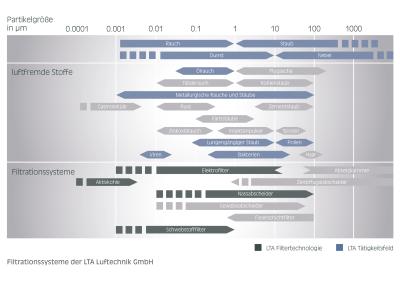
Viruses, bacteria, pollen and other germs can be found on surfaces and in the air. Their concentration can reach particularly high levels in closed rooms. Filtration systems significantly reduce the concentration of these harmful substances. They filter harmful pollutants such as pollen and spores from the air. Viruses measure between 0.05 and 0.12 μm in size.
In the case of viruses and germs, the use of electrostatic filtration systems with HEPA post-filters (High Efficiency Particulate Air) is recommended. These filters have an efficiency factor of over 99.95% and can separate particles larger than 0.01 μm. HEPA post- filters are ideal for high-traffic areas such as manufacturing plants, conference rooms, open-plan offices, cafeterias, and waiting rooms. In addition, electrostatic filtration systems have disinfecting and odor-eliminating properties that kill off viruses and bacteria and substantially improve indoor climates.
In the mechanical and metalworking industries, turning, milling, and grinding can all produce oil and coolant mist. Oil mist consists of particles from coolants, which become suspended in the air as aerosols.
These microparticles or aerosols of approximately 1 μm in size are hazardous to health and reduce the efficiency of machine tools, while also contaminating machines, measuring devices, floors, and production halls. Electrostatic or mechanical filtration systems with an efficiency factor of over 99.9% improve production conditions by reliably protecting employees in their places of work. Reusuable, low-maintenance filter elements increase the sustainability and cost effectiveness for the entire production chain.
As is the case with oil mist, dust and smoke produced during metalworking and production are also hazardous to health and increase wear. Mechanical filtration systems for dust improve health, working conditions, and production safety.
Contact Details
Related Glossary Terms
- coolant
coolant
Fluid that reduces temperature buildup at the tool/workpiece interface during machining. Normally takes the form of a liquid such as soluble or chemical mixtures (semisynthetic, synthetic) but can be pressurized air or other gas. Because of water’s ability to absorb great quantities of heat, it is widely used as a coolant and vehicle for various cutting compounds, with the water-to-compound ratio varying with the machining task. See cutting fluid; semisynthetic cutting fluid; soluble-oil cutting fluid; synthetic cutting fluid.
- gang cutting ( milling)
gang cutting ( milling)
Machining with several cutters mounted on a single arbor, generally for simultaneous cutting.
- grinding
grinding
Machining operation in which material is removed from the workpiece by a powered abrasive wheel, stone, belt, paste, sheet, compound, slurry, etc. Takes various forms: surface grinding (creates flat and/or squared surfaces); cylindrical grinding (for external cylindrical and tapered shapes, fillets, undercuts, etc.); centerless grinding; chamfering; thread and form grinding; tool and cutter grinding; offhand grinding; lapping and polishing (grinding with extremely fine grits to create ultrasmooth surfaces); honing; and disc grinding.
- metalworking
metalworking
Any manufacturing process in which metal is processed or machined such that the workpiece is given a new shape. Broadly defined, the term includes processes such as design and layout, heat-treating, material handling and inspection.
- milling
milling
Machining operation in which metal or other material is removed by applying power to a rotating cutter. In vertical milling, the cutting tool is mounted vertically on the spindle. In horizontal milling, the cutting tool is mounted horizontally, either directly on the spindle or on an arbor. Horizontal milling is further broken down into conventional milling, where the cutter rotates opposite the direction of feed, or “up” into the workpiece; and climb milling, where the cutter rotates in the direction of feed, or “down” into the workpiece. Milling operations include plane or surface milling, endmilling, facemilling, angle milling, form milling and profiling.
- turning
turning
Workpiece is held in a chuck, mounted on a face plate or secured between centers and rotated while a cutting tool, normally a single-point tool, is fed into it along its periphery or across its end or face. Takes the form of straight turning (cutting along the periphery of the workpiece); taper turning (creating a taper); step turning (turning different-size diameters on the same work); chamfering (beveling an edge or shoulder); facing (cutting on an end); turning threads (usually external but can be internal); roughing (high-volume metal removal); and finishing (final light cuts). Performed on lathes, turning centers, chucking machines, automatic screw machines and similar machines.
